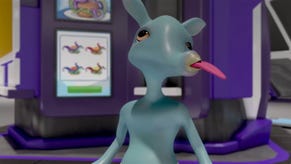Retro: Startopia
XCOM: Let's All Be Friends edition
'Twas an odd coincidence that Startopia and Double Fine's Spacebase DF-9 alpha arrived on Steam so hot on each other's heels. The current paucity of activities in the latter would have had me hankering for the former even if a digital postman were not able to immediately deliver it to my hard drive - it's one of few games I still have a hard copy of lurking on my shelf. Mucky Foot's space station-set management game was something of an era-ender, the last great gasp of the Theme Park descendant genre as-was. We're seeing a renaissance of sorts of now, with Prison Architect, Spacebase and the craven Godus, but the fully-formed, big budget age essentially ended with Startopia (though you could argue similar for the muddled Republic: The Revolution, a deeply strange Icarus of a game from Mucky Foot's fellow post-Bullfrog offshot, Elixir.)
I've made Startopia my destination once again for the last couple of days, my first extensive revisit in many years, and I'm relieved to discover that it now exudes at least some of the timeless quality to be found in relative contemporaries such as Dungeon Keeper and Theme Park.
As you've already seen, it manages to be beautiful even though any number of grumbles about geriatric lighting and character models could rightfully be pinned on it. Sadly the unofficial (yet dev-made) 1.02 patch which added dynamic shadows to the game appears to nullify the widescreen mod, so I made the difficult decision to choose scale over shadow. Oh, how I dream of a hybrid patch.
As I mentioned, one of the great things Startopia does is to give the player near-absolute camera control, which does wonders for the many moments where not a lot's going on and you simply want to watch the assorted alien races who crew and visit your growing space station going about their business. They sleep, eat and shit, they shop, they use 'love chairs', they leave their bloody litter all over the place, and they have an inexhaustible need for accommodation and entertainment. It's classic management stuff, but the combination of scale and strangeness makes the game feel weirdly non-traditional even now.
On that scale, by the way - obviously there's the dramatic, galactic exterior shots, but while the interiors are less brazenly beautiful, essentially setting the meat of the game within towering, metal-walled warehouses, their use of extremely high ceilings and 2001-style curved floors (for each section of the space station is simply a small slice of an enormous donut in the stars) manages to make the busywork of building and hiring feel both claustrophobic and colossal; a genteel, titanic prison.
A wonderful game to watch then, with the simplicity and smoothly lurid colour of the character models and textures meaning it could as comfortably pass for a modern-day, high quality indie game as it could the best big-publisher efforts of 2001. As for how it plays, that's a more mixed bag. It's an odd cocktail of calm and frantic, with an interface that's on the one hand impressively minimal for the age but on the other often counter-intuitive. Managing and recruiting staff, for instance, is a tiresome matter of browsing skill, diligence and loyalty attributes from a list, then click on an icon to zoom to the creature you want to hire, then having to right-click on it to bring up a new menu, from which you can then hire, fire or promote the thing. Too many clicks, too much dissonance between identifying what you want and actually making it happen. But it's a complication more than a problem.
Sandbox mode is a greater pleasure than the series of missions, which can be a little too exacting in their requirements and thus constricting of your indulgences, but goals have forever been important, and it's a useful way to ease in to what's a respectably complex system of building and citizen dependencies. The missions are well-themed, too - for instance, cure 100 sick aliens with your hospitals before 10 of them expire from their assorted space-plagues, and all the while sniffy health inspectors sent by the Greys assess whether your facility is clean enough. That's a lovely concept, theming your space station as a struggling health outpost - ER amongst the stars - rather than just 'build/kill x wotsits', and it's that focus on creating character and setting that defines the game as a whole.
Sadly, living out the above theme highlights micromanagement irritations that live deep in Startopia's glistening flesh. Keeping the place clean, for instance, involves buying enough Scuzzer droids, then selecting recycling priority for most every one you can locate, and even then you'll be desperately clicking on discarded wrappers and rotting leftovers manually and depositing it in the recycler building yourself, as the droids just can't keep up with resident's relentless littering. Meanwhile, hiring more Scuzzers, or buying trash cans, or indeed extra of almost any type of building, is dependent on trading with an unseeen, infrequently visiting shopkeeper who sounds like a Vogon.
If you don't have enough money to buy what you need when he pops up - in the form of a small email icon on the lower left of the screen - he'll bog off again and you'll just have to wait until whenever his next visit is. Sure, it's in keeping with the idea that you're in charge of a lonely hunk of metal floating in empty space, rather than a small business with wholesalers just a few streets away, but it does feel like an artificial restriction and introduces an unwelcome sense of powerlessness. And I'm not even going to start on the combat, it's an enormous misfire which feels like a different, dumber game got bolted onto a far smarter one.
(I feel so guilty that I'm picking holes in something I'm so fond of, but this is after all a game you can buy now, so I should treat it in kind rather than write a love letter.)
The reward for the busywork is invariably worth it. A station filled with berths and food stations and sickbays and recyclers and com stations and motels and music shops and weird momuments is glorious to behold, both in its scale and its business. There's so much going on, and it evokes an elaborate simulation even if the truth is somewhat simpler (at least compared to Dwarf Fortress, or what Spacebase claims to be aiming for).
Small actions, such as opening up a new section of the station to build in, feel momentous - hulking doors the height of castle slowly open, unearthly light gleaming from the widening crack, and when what lies beyond is finally revealed, the yawning size of that empty metal floor, curving so strangely, seems impossible. Soon enough, it'll be as bustling as the rest of the station, though - buildings are big, space is filled fast, and a dead space comes to life with gratifying speed. And when you get to visit the biodeck, to reshape the proto-land within and to move the camera freely out to the stars, making you and all that micromanagement you were obsessed with in the decks below feel so tiny and inconsequential, that's when Startopia feels timelessly special.
It's far from an unqualified success, but weirdly it does feel like a game whose time has come. Not successful enough to ensure Mucky Foot's future at the time, which is at least as much due to punter ennui with the late-90s glut of increasingly uninspired management games as it was reviews or issues around sci-fi games, in a 2013 context it seems that much more ambitious, non-commercial,strange and precious.
Startopia is on Steam, now.















